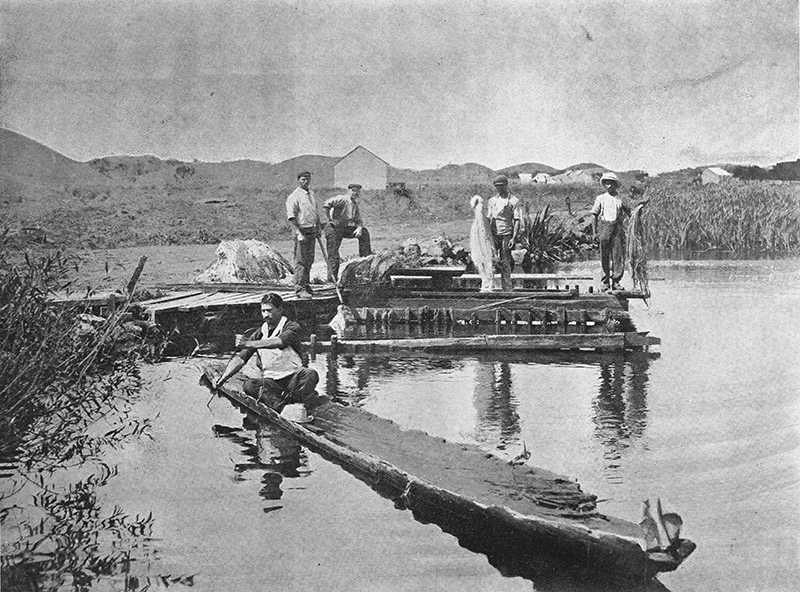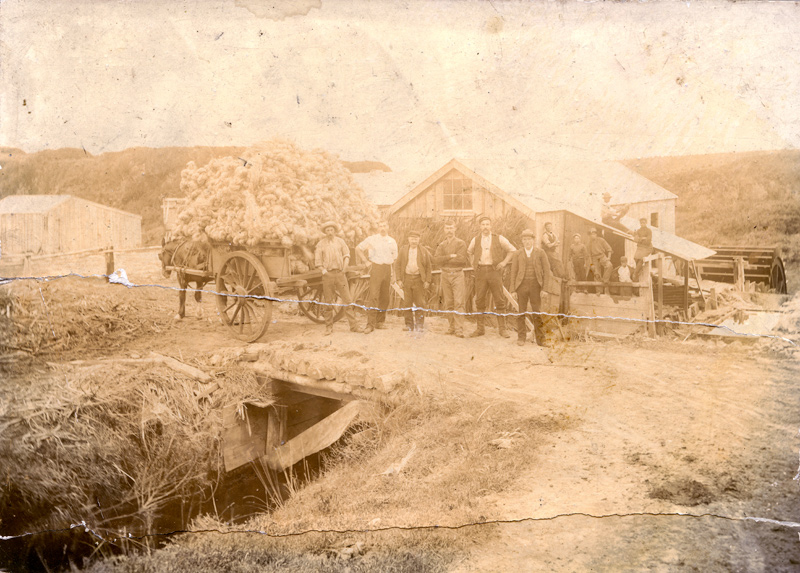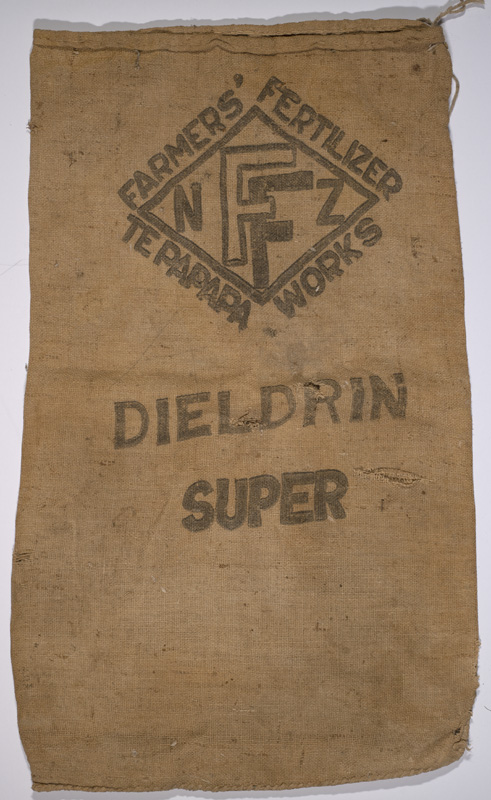



The Taranaki coast has long been famous for its fine varieties of flax, which grew between the sea and the bush. Not many of us know that part of Surf Highway 45, which curves south around the coast from New Plymouth, was laid where it was because that's where the flax ended and the lowland bush began. From Stony River to Opunake, it was this boundary that determined the road.
Flax was always abundant in New Zealand. Māori scraped it with mussel shells, wove it into fishing nets, made eel traps and tukutuku panels to decorate whare. Flax string was used in children's games. All ropes and bindings were made with this natural fibre.
When European sailors began arriving in New Zealand with a need to replace the rigging on their sailing ships, a wider potential was seen. As the standard length of rope required just to drop anchor was 120 fathoms (311 metres), the market was a big one.
In the 1700s, the British Navy alone used an estimated 25,000 kilometres of rope, enough to go half way round the world, and as the natural fibre constantly rotted it had to be replaced every four years. Every inch was made by hand in the British dockyard rope walks, usually from hemp grown on the Russian Steppes or in Manila in the Philippines.
In Taranaki, trader Dicky Barrett was quick to launch a money-making scheme, supplying a steady stream of stripped flax, or muka, to Australian merchants. When he began shipping it to Sydney in the early 1830s he became the first European here to trade in it.
In the earliest days, Māori were crucial to the industry. Experienced and well-motivated, they could earn one musket per tonne of processed fibre. As Māori moved further out from their hilltop pā into swamps and wetlands where flax was the most abundant their health often suffered as a result. Though working with flax was considered mainly women's work, slaves were often kept as free labour to help process it for sale.
Around the time the Treaty of Waitangi was signed in 1840, small boat building yards were already being established on these shores, setting off a further demand for local rope. New Zealand went headfirst into the rope business. Soon, our very first manufactured product was being exported in significant quantities overseas.
But once the 1860s New Zealand Wars began, the Māori workforce drained away. The Government, thinking quickly, began to offer cash prizes for the development of machines to process flax instead. Soon, new machines were built that could process a quarter of a ton per day. Later, they would do five times that.
At one time, a staggering 300 flax mills were operating in New Zealand, yet less than seven years later, only 40 mills were left.
Flax is actually a lily and could be cut every four years. At first, mill hands, like Māori before them, took only the outside leaves so the plant could regenerate on its own. Eventually, the whole plant was harvested and the roots dug up, divided into clumps and replanted.
A human flax cutter could cut between one and two tonne per day, but the work was hard and hot. A man had to be tough enough to hoist a three or four metre bundle onto his shoulders, balance it and walk a long distance to the dray over swampy ground.
Once inside the factory, the flax was fed into a stripping machine, which took all the green covering off the fibre and left it bare. The fibre then fell from the machine onto an endless moving chain which caught and carried it under a strong jet of water to wash it.
At the far end of its journey, the fibre was taken from the chain by hand, loaded onto drays and hauled to the drying paddocks, to be spread on the ground or along plain wire fences to dry. Once dry, it was again collected on drays, and back it went to the mill to be fed through a machine with wooden beaters, called a scutcher. As Mr Kelly, from the Cape Egmont mill, once explained: "The scutcher is somewhat similar to the stripping drum in principle. It is larger and has fewer eaters and as it revolves at 150 to 200 revolutions per minute, it requires no feed rollers to hold the hanks of fibre which are submitted to its operation.
"A workman takes a hank in his hand and throws it into an opening in the lining case surrounding the scutching drum. The revolving beaters strip off all the tow and loose matter. He then reverses the end of the hank, and when completed, it is ready for packing. The flax is then baled up in bales of two to three hundredweight, in an ordinary screw press and tied with flax rope, and when marked with the proper brand, is ready for market." The bales of finished fibre were sold to rope and twine makers, locally or overseas, while the short tangled tow teased out by the scutcher went to furniture makers for stuffing armchairs and sofas.
On a clear, still day, the steady ring of steel on steel from a flax mill could be heard right across the countryside, while inside the mill, the noise of the stripper and up to six spinners working at one time, spelled increasing deafness for the mill hands.
At one time, Taranaki had so many mills processing flax that many young men found their first jobs there. From the Taranaki Herald, 22 May 1889: "The flax industry on this coast has been developed during the last eight months to a degree that is not realised by every man.
"Since the flax boom commenced steady progress has been made in the industry and the mills have steadily increased until at present time there are about 20 between Awakino in the north and a little beyond Opunake in the south, and as the article manufactured still sells for a good price, which gives signs of permanency, there is every reason to suppose that more mills will be in operation during approaching summer.
"To give an idea of the work done in the mills on this part of the coast, some inquiries have been made respecting them and the results will show the public what a flourishing industry has sprung up in such a quiet way.
"The mills that inquiries have been made about are those situated between the Stony and Oaonui Rivers - a distance of about 20 miles.
"There are between these limits, nine mills in operation employing at present 258 hands. One property employs 97, another 53, a third 45, a fifth 41, a sixth 12, a seventh 10, and it's said there is still room for more hands, in view of the increased work that will be done during the approaching summer.
"In addition, there are some 200 Maoris employed pretty constantly, supplying flax and then there are others who get their employment from the fact of the mills working like carters of the dressed flax, for instance, who are not reckoned in the numbers above."
Right from the beginning, it was always boom or bust. The New Zealand flax market fluctuated wildly and many mills were short-lived. While initially, the supply to mariners for rigging and ropes was steady, when sail gave way to steam the market failed.
For a time, the Spanish/American War of 1888 affected supply of hemp from Manila, lifting sales from New Zealand, but when the war ended, the market plummeted again.
In the early 1900s, a virus called yellow leaf swept through flax country, having a devastating effect on harvest. Though no one could ever agree on a cause, the general belief was that it might have been due to the draining of swamps and the new trend of growing flax on dry ground. Perhaps that belief was right. When much of land was re-flooded, the flax recovered quickly.
Reaper-binder machines, invented for large scale hay harvesting meant an upsurge in demand, as huge amounts of baling twine were needed to bind the hay. An international grading scheme put in place in 1909 saw a new resurgence in the trade, with old mills being reopened and new mills built.
Though Dunedin's Donaghy's Rope and Twine Company dominated the industry, they at least provided a new and steady market for the fibre. Business picked up slightly when World War One created a need for parachute ropes, but when war ended, so did the sales. Land was cleared of flax and put into pasture.
Eventually, despite man's best intentions, the once throbbing mills fell silent, were dismantled and disappeared. Today, if you know where to look, you might find a millpond or two along the coastal road, but there is little else to mark Taranaki's first manufactured export, which finally gave way to a more profitable and sustainable industry: dairying.
Bell, F.D. (1842). Reasons for Promoting the Cultivation of the New Zealand Flax. London: Smith, Elder & Co.
Please do not reproduce these images without permission from Puke Ariki.
Contact us for more information or you can order images online here.